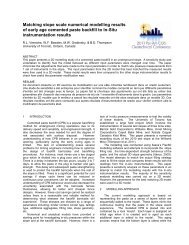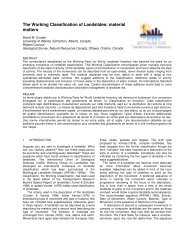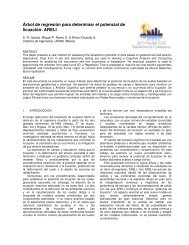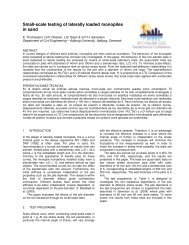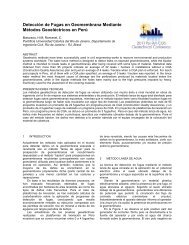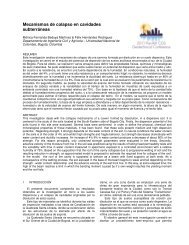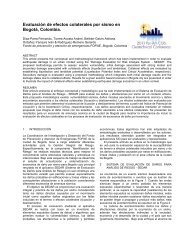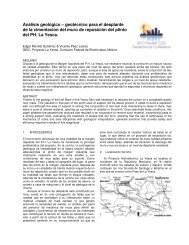MS Word Technical Paper Template
MS Word Technical Paper Template
MS Word Technical Paper Template
Create successful ePaper yourself
Turn your PDF publications into a flip-book with our unique Google optimized e-Paper software.
Container pH ORP Ni<br />
(colorimetry)<br />
Ni<br />
(ICP-AES)<br />
C1-1 7.45 95.5 1.845 1.81<br />
C1-2 7.05 103.2 1.65 1.8<br />
C1-3 7.11 101.1 1.88 1.78<br />
C4-1 6.83 NA NA 1.9<br />
C4-2 6.82 NA NA 2.03<br />
C4-3 6.72 NA 1.235 2.09<br />
The nickel-rich water was watered by overhead irrigation<br />
on cells C1 and C4 over several hours using a garden<br />
sprinkler. A total of 3000 L was watered in two periods for<br />
C1 and C4 (see Figure 4). The effluent produced was<br />
sampled hourly using an automatic peristaltic sampler.<br />
Nickel concentration in the effluent samples was<br />
evaluated on site using colorimetry and in the laboratory<br />
using ICP-AES. The effluent’s pH was measured<br />
sporadically using a pH probe and meter. The effluent<br />
flowrate was also evaluated sporadically using a<br />
graduated cylinder and a stopwatch.<br />
The results obtained are presented below. The Ni<br />
concentrations presented are those obtained through ICP-<br />
AES analyses (free mobilized analytes). Colorimetry was<br />
used on the field mostly as an indicator to estimate the Ni<br />
content of the feed water and a few times to check the<br />
effluent. The ICP results usually matched well those<br />
obtained by colorimetry.<br />
4.1 Flowrate<br />
Ni-rich water was sprinkled almost continuously for two<br />
periods for each cell, for a total of 530 minutes for C1 and<br />
542 minutes for C4. The corresponding flowrate is 5.7<br />
L/min for C1 and 5.4 L/min for C4. However, the<br />
measured flowrates, presented in Figures 5 and 6, are<br />
below these estimated values. The watering periods are<br />
indicated by the dark arrows. It suggests that part of the<br />
water added is retained in the cell, and that the duration of<br />
the watering was not enough to reach the steady state in<br />
terms of water flow. Also, it is possible that a portion of the<br />
water added was lost to evaporation and that a very low<br />
amount may have been projected outside the cell during<br />
sprinkling (minimal according to field observations).<br />
4.2 Ni concentrations<br />
Figures 5 and 6 show the trend of the Ni concentration in<br />
the effluent of both cells, with the watering period and the<br />
measured flowrates. For C1, the Ni concentrations<br />
remained low throughout the test, generally below 0.02<br />
mg/L. During the second watering period, Ni<br />
concentrations reached 0.15 mg/L for a short period, then<br />
returned back to below 0.02 mg/L once watering was<br />
stopped. The Ni concentrations obtained in the effluent of<br />
cell C1 were well below the input concentration of 1.8<br />
mg/L.<br />
Cell C4 shows a different behaviour. The Ni<br />
concentration in its effluent rose rapidly with the water<br />
input for the watering from an initial concentration of 0.257<br />
mg/L to 1.75 mg/L, and the concentration at the effluent<br />
stayed elevated even after the water input was turned off.<br />
During the second watering period, Ni concentrations rose<br />
above 2.5 mg/L, and slowly decreased to reach 1.26 mg/L<br />
by the end of the test.<br />
4.3 Ca, Mg, S concentrations<br />
Figure 4: Field set-up for retention tests: water sprinkler<br />
on top of cell (top) and colorimetry and pH/ORP<br />
equipment (bottom).<br />
4 RESULTS<br />
Figure 7 to 10 present the evolution of the calcium,<br />
magnesium and sulphur concentration in the effluent of<br />
both cells. The three elements concentrations follow the<br />
same pattern for a given cell, with a spike in concentration<br />
shortly after the watering period. For C1, the first peak<br />
concentrations occurred within 8 hours of the beginning of<br />
the watering. Ca and S concentrations at the effluent rose<br />
to values near the input water concentration. When<br />
watering was stopped, Ca and S concentrations stabilized<br />
and then rose again with the second watering period.<br />
During that period, Ca and S concentrations at the effluent<br />
rose above the input concentration. Effluent<br />
concentrations decreased once watering was stopped. A<br />
similar behaviour was observed for Mg, however the input




